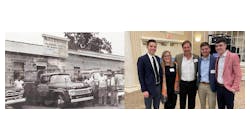by Tom Ewing
Regulatory reform has been a consistent focus for President Trump. To get that reform underway, at least for energy, the president, last March, issued Executive Order (EO) 13783 requiring agency heads to “review all existing regulations, orders, guidance documents, policies and any other similar agency actions that potentially burden the development or use of domestically produced energy resources with particular attention to oil, natural gas, coal and nuclear energy resources.” The completed reviews go to the president for his evaluation.
DOE’s work started in May. It included a public comment period which ended on July 14. DOE received 132 comments and used those comments to complement the work of an internal regulatory reform task force. DOE’s Final Report on Regulatory Review, released on October 25 and signed by Energy Secretary Rick Perry, contains four broad suggestions:
- Streamline natural gas exports
- Review National Laboratory Policies, i.e., the labs that support the Department’s energy, science and nuclear non-proliferation missions.
- Review National Environmental Policy Act (NEPA) Regulations and Implementation
- Review DOE’s appliance standards program.
DOWNLOAD THE ENTIRE REPORT BELOW
Of the four recommendations, the focus on appliance standards receives the most attention. DOE cites a number of policy topics important for the HVAC industry, particularly DOE’s energy conservation standards, which cover more than 60 categories of appliances.
The Energy Policy and Conservation Act (EPCA) of 1975 requires DOE to review and, when necessary, implement or revise minimum energy conservation standards. EPCA established a six-year review cycle. Many business leaders complain that the six-year cycle demands almost constant changes in plants and equipment because as managers prepare for the new standards, they quickly confront the next round of review, and, yet again, new investments that, over time, only yield smaller and smaller gains in efficiency.
DOE’s report suggests a number of steps to check what many businesses see as system that all but guarantees perpetual rulemaking.
At the top of the list: review the Process Rule – that’s the 1996 Rule (10 CFR Appendix A to Subpart C) setting DOE’s guidance for considering new or revised EPCA standards. Secretary Perry says DOE will “consider issuing a RFI to gather additional feedback from stakeholders on how to amend or improve the Process Rule.”
Perry notes that revising EPCA itself requires congressional action – that takes time. In the meantime, Perry said DOE will focus on actions it can take at the Agency level, including:
- Leaving standards unchanged when that is supported by data and when small energy savings require significant upfront costs.
- Consider voluntary, non-regulatory and market based alternatives. For example, letting DOE use established industry test procedures when that is “appropriate and consistent with the law.”
- Reconsidering standards and test procedures for particular products. Sec. Perry specifically cites a re-look aimed at commercial packaged boilers, commercial and industrial fans and blowers, the 2016 refrigerated beverage vending machine standards rule, the 2014 residential furnace fan rule and the 2010 residential water heaters standards.
- Reevaluating test procedures, including those for compressors, residential central air conditions and heat pumps and consumer and commercial water heaters. Test procedures are another separate body of regulatory work, standing in addition to product efficiency standards.
Another important move by Perry is in the area of climate change analyses. EO 13783 withdrew certain documents concerning the development of the “Social Cost of Carbon” (SCC), a frequently challenging metric for energy and HVAC industries. The SCC seeks to affix a monetary value linked to possible consequences from higher versus lower levels of carbon emissions. SCC depends on complex mathematical modeling that covers decades, making cost-benefit predictions rather sketchy, some would say wide open to challenge.
For climate analyses, the EO requires agencies to use Office of Management and Budget Circular A-4. Perry declares directly that “DOE will follow these requirements in our regulations.” He also notes that some commenters encouraged DOE not to use SCC to calculate the climate impacts of regulations.
The Secretary rejects that advice and retains a climate analysis. However, one critical aspect of Circular A-4 is that it uses a high discount rate – 7 percent – to estimate future costs and benefits. In SCC modeling, a high rate decreases long-term benefits. Therefore, when the SCC value is lower so too are presumed benefits from energy efficiency, particularly when offsetting climate change is one major benefit.
Unfortunately, despite referencing a lot of good ideas, the report maintains a passive voice; it’s hard to tell which recommendations and suggestions will get some action, and when. The report has no temporal aspect, no schedule or time-line. It doesn’t list priorities. Despite his direct reference to the Process Rule, for example, Secrectary Perry doesn’t really commit to anything, he just writes that the Department “will consider” next steps on rule review. DOE’s press office did not answer inquiries about timing and priorities.
Right now, DOE’s report has a lot of potential energy, possibilities. Hopefully that changes soon, into a real program of work.
Tom Ewing is a freelance writer specializing in energy and environmental issues.








